By Charles Q. Cutshaw
For several years the Russian firm TsNIITochmash has advertised several innovative rifles and pistols for sale on the international arms market, all designed to Russian military and police requirements. The weapons’ innovations generated a great deal of interest in the West, but there were no opportunities to actually fire them until mid-1997, when an agreement was reached between an American firearms importer, TsNIITochmash and the U.S. government for the firearms to be evaluated by representatives of both government and industry. This writer was among those invited to attend the demonstration and was afforded the opportunity to fire and disassemble most of the weapons. As a result, virtually all of the questions regarding these mysterious Russian firearms have now been resolved. The weapons have in several instances been in service with the Russian military and police for some time. All of them are chambered for new cartridges which break with the traditional Soviet/Russian calibers. The weapons include a new high-capacity high-powered pistol, a pistol that fires silent ammunition, a compact assault rifle, two suppressed rifles and two underwater firearms – a pistol and an assault rifle. There is also what must be the most unusual military knife in history.
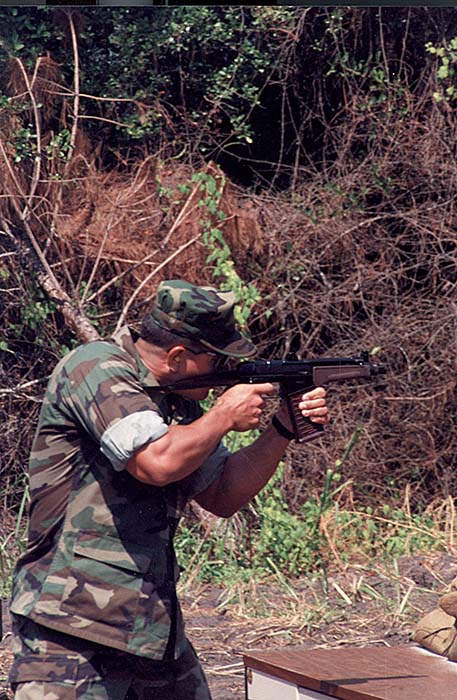
The first weapon we will consider is the Gurza pistol, which created quite a stir when it first appeared in 1993. It has a magazine capacity of 18 rounds of a new 9x21mm (Russian nomenclature RG-054) cartridge that delivers terminal ballistic performance in the .357 magnum spectrum. This new cartridge is not the same as the western 9x21mm, which is based on the 9x19mm Parabellum round with performance levels to match. The 9x21mm Russian, as we have designated it to differentiate between it and the Western round, is based on the 9x18mm Makarov case. Case head dimensions are identical to those of the 9x18mm in those 9x21mm examples that have been examined by the author. Moreover, the 9x21mm Russian round was designed from the outset to defeat both soft body armor and car bodies. This reflects the increasing crime problem in post-Soviet Russia, where criminals generally wear body armor and drive high – powered automobiles. The nose of the 9x21mm Russian bullet has a steel penetrator protruding from the guiding metal jacket. According to Russian literature, this provides a penetration of 30 layers of Kevlarr and two 1.2mm thick titanium plates at a range of 50 meters. There is no reason to doubt this, as the Gurza bullets we fired into National Institute of Justice (NIJ) Level IIIA (.44 Magnum protection level) body armor at 50 meters during the tests were cleanly penetrated with the bullet passing deep into a heavy rubber mannequin over which the protective vest was placed.
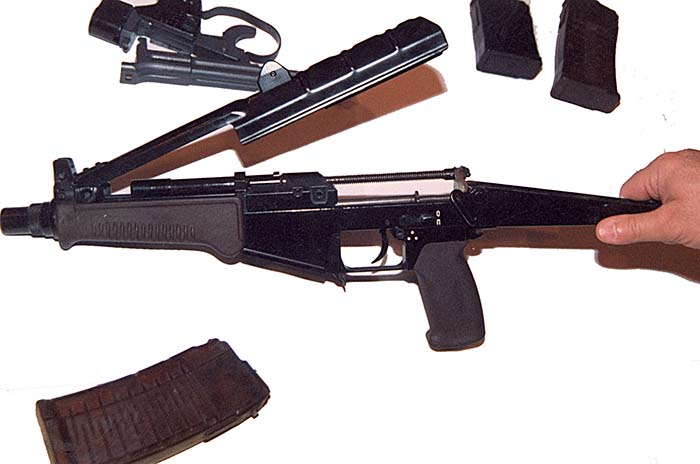
The Gurza pistol itself is a curious design. Unlike other modern pistols whose frame is made entirely of polymer, the Gurza uses polymer only for the grip and trigger guard. The upper portion of the frame is constructed of steel. The boundary between the polymer lower and steel upper portion of the frame can clearly be seen in the photographs taken at the test range. Another unusual feature of the Gurza is it’s trigger action. The pistol uses a conventional hammer, but it is not double/ single action as appearances would indicate. When the hammer of the Gurza is fully down, the trigger is completely disengaged from the sear mechanism. Pulling it does nothing. Placing the hammer in a half cock position actuates the trigger into a “double action” mode. Pulling the trigger brings the hammer to full cock and then drops it, firing the weapon. The firing mechanism then goes to single action after each subsequent shot. The single action of the Gurza would be unacceptable to a Western military or police activity. Trigger pull on single action is no more than 1.5 to two pounds with no take-up whatsoever! I was the first American to fire the Gurza and was caught totally by surprise by the light weight and sensitivity of the Gurza’s single-action trigger, resulting in my first shot being fired as my finger touched the trigger, causing the shot to miss the target. Subsequent shots were all hits, but the trigger of this pistol is entirely too light for operational use by Western military or police. When asked about this, the Russian representatives stated that the light trigger pull was a requirement from the unspecified agency which originally requested the pistol.
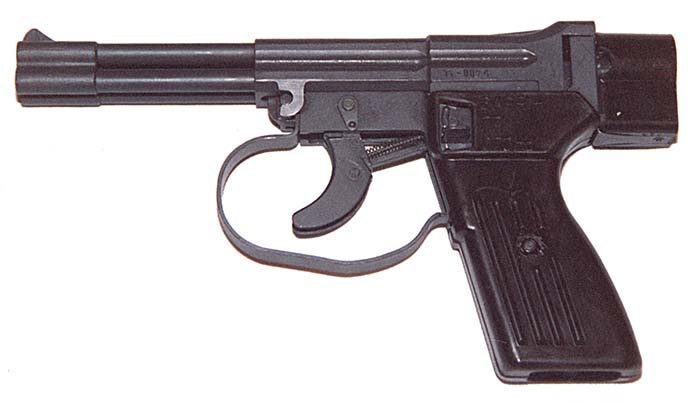

The Gurza has no external safety mechanisms other than a grip safety, visible at the upper portion of the pistol’s backstrap and the trigger disconnector when the hammer is fully down. It is not known if there is a firing pin block. Locking is based on the “dropping block” principle originated by Walther, and currently in the Beretta Model 92 series. The magazine release is ambidextrous and releases by pressing forward with the thumb. When the release is pressed, the magazine drops free. There were no stoppages whatsoever while the Gurza was fired hundreds of times by numerous attendees. In fact, reliability characterized all the weapons brought by TsNIITochmash. None had a single stoppage. The polymer grip of the Gurza is at a comfortable angle which appears to be close to that of the Colt M1911, considered by many to be nearly ideal. This writer found the pistol to be easy to control and muzzle rise to be quite manageable, despite the high – velocity cartridges. The only serious complaint about the Gurza is its single action trigger mechanism, which is so unusual as to be considered bizarre by virtually all present and categorically unsafe in single action mode.
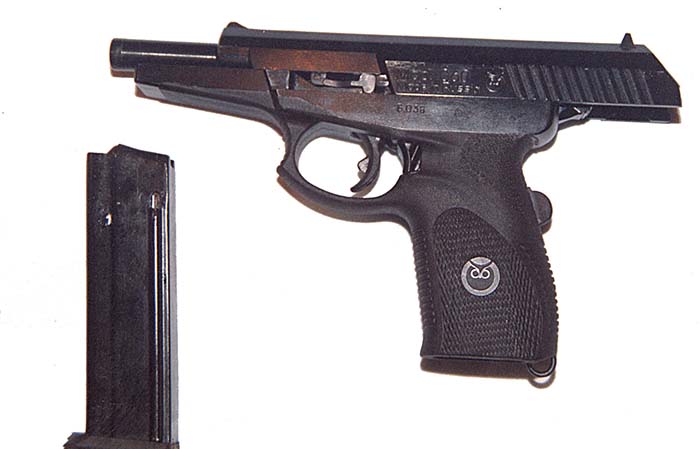
Other than its ammunition, the PSS pistol brought for test by TsNIITochmash is a conventional blowback operated semiautomatic pistol. The PSS was designed to a special operations requirement and is unique in that it fires a silent (not suppressed) cartridge. The only sound to be heard when the PSS is fired is the movement of the slide back and forth. It is odd in a pistol of this type that there is no means of locking the slide in place so that the sound of its movement is eliminated. Other than the movement of the slide, the sound level of the PSS approximates that of an air gun.
The PSS fires the SP-4 silent cartridge developed especially for it and the NRS-2 “Special Scout Knife” described below. The captive piston technology involved in this unusual cartridge is not new; it was used during the Vietnam War for silent revolvers employed by American “tunnel rats.” The silent cartridge eliminates both the weapon’s muzzle blast and the bulky silencer “can” usually associated with suppressed weapons and allows the PSS to be a very compact pistol.
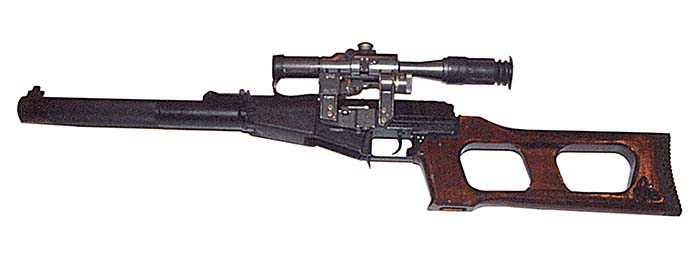
The SP-4 cartridge piston propels a simple steel cylindrical bullet with a copper rotating band down the rifled barrel of the PSS. The piston’s forward motion is stopped against the internal shoulder of the thick cartridge case, sealing the propelling gases inside. They are slowly and silently bled off. SP-4 casings examined by the author have no headstamp to identify their origin, although given the publicity attained by the weapons that fire the SP-4 cartridge, there can be little doubt as to the origins of such unusual cartridges.
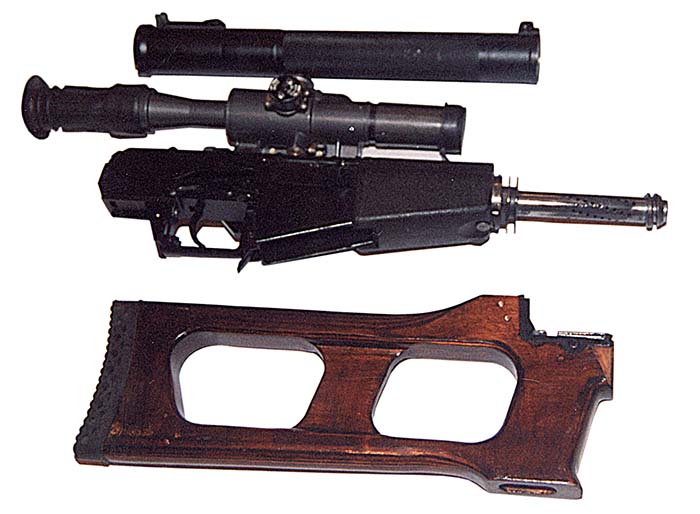
The compact size of the PSS and its ability to fire in silence without requiring an external suppressor make it ideal for assassinations, kidnappings and similar special missions. The pistol is also well – suited for police SWAT work where minimum noise levels are required. The PSS is easily concealable in a jacket pocket or in the issued shoulder holster that accompanies each pistol in its factory box. The PSS utilizes a steel frame, with polymer grips which also constitutes the lower frame. There is no conventional gripstock as in most Western designs. Operation of the PSS is straight blowback. There is a Makarov-style safety on the slide and functioning is similar to that of the Makarov. There are no unusual trigger mechanisms as with the Gurza. The PSS is pleasant to shoot, with little felt recoil and although the Russians claim an effective range of 50 meters, that is questionable given the relatively low velocity of the SP-4 cartridge which is subsonic with a fairly lightweight bullet of abysmal aerodynamics. This, coupled with a very short barrel length, does not indicate an effective range much greater than the distance which the PSS was fired during our evaluation – some 25 meters. Nonetheless, the PSS is a very effective pistol for its intended purpose of close range shooting in military special operations or police SWAT missions. Its lack of muzzle blast would also make it ideal for use in confined spaces.
The MA “Vikhr” Compact Assault Rifle is occasionally referred to in the Western press as a submachine gun, but this is not the case; a submachine gun by definition fires pistol cartridges, while the MA fires a “intermediate” caliber cartridge, the 9x39mm SP-5 and SP-6. Both of these “special” cartridges are derived from the venerable 7.62x39mm and fire a massive 250 grain bullet of great sectional density at subsonic velocity. The lead cored SP-5 is a full metal jacket (FMJ) “ball” round, while the SP-6, with its steel penetrator, is armor-piercing. The MA is one of several recent Russian weapons that fire this new and apparently very effective round. Two of these, the AS suppressed assault rifle and the VSS suppressed sniper rifle were also tested during the TsNIITochmash visit and are discussed below. We will discuss effectiveness of the SP-6 round in more detail under the section on the AS and VSS.
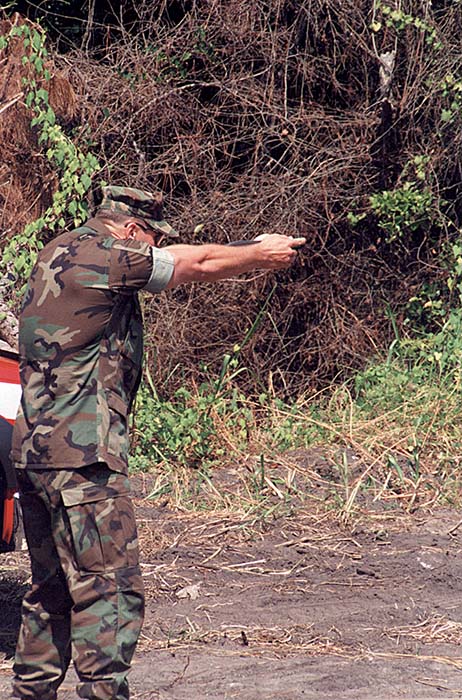
The MA is a gas – operated compact assault rifle derived from the basic Kalashnikov, but with significant differences. The selector lever, for example, is ambidextrous and has been moved to a position at the rear of and above the trigger guard where it can be manipulated by the operator without removing his hand from the grip. The receiver cover is not readily detachable; when released, it pivots up at the front just behind the foresight for access to the operating components. A major difference between the MA and similar weapons is that the MA is striker fired, rather than using a hammer. The design is otherwise conventional and follows the Kalashnikov AK-100 pattern, using primarily stamped metal and polymer components. The compensator at the front of the barrel enables control to be maintained while firing on full automatic. The MA has no burst feature.
The ammunition is a critical component of the MA system. A conventional compact assault rifle firing 5.56x45mm NATO ammunition would have an unacceptable muzzle blast because that cartridge’s powder charge is designed to be consumed in a much longer barrel. The 5.56x45mm is also supersonic, which adds a sharp “crack” to the muzzle blast. The heavy subsonic bullet fired by the MA and other weapons in 9x39mm caliber eliminates this problem. Muzzle blast is reduced by lowering the powder charge to a level where it is consumed in the short barrel of not only the MA, but the two suppressed assault weapons discussed below. Terminal effects are maintained by a heavy (250 grain) bullet with a high sectional density. The MA is not intended for long range work; its maximum effective range is only 200 meters, but this is significantly higher than pistol -caliber submachine guns, and is well within the range of most battlefield encounters. Magazines are of translucent polymer construction and are available in either 10 or 20 round versions, although efficacy of a 10 round magazine in a weapon such as this is questionable. Like the other weapons demonstrated, the MA functioned flawlessly.

Because of their similarities, we will treat the VSS “Vintorez” (Thread Cutter) suppressed sniper rifle and AS “Val” (Rampart) suppressed assault rifle as one. The primary difference between the two is the furniture; the mechanism and functioning of both rifles are identical. Both rifles fire the 9x39mm round. The primary round for the VSS is the SP-5 FMJ due to its increased accuracy over the SP-6 AP. Conversely, the SP-6 is favored for use in the AS assault rifle, because of it’s better terminal ballistics. On the range, however, we fired SP-6 rounds from the VSS and were able to penetrate both sides of a U.S. Kevlarr helmet at 150 meters, although the first shot missed. Using a magazine loaded with SP-5 FMJ rounds in the VSS, however, the author was able to hit several eight inch (203mm) steel targets at 150 and 200 meters with every shot. The claimed effective range of the VSS is 400 meters, and there is no reason to doubt this, given its accuracy at 200 meters, the limit of the range we used.
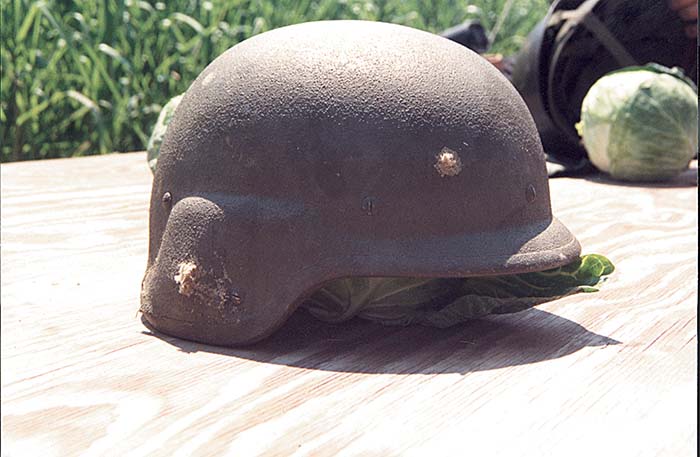
Like many similar Russian weapons, the AS and VSS were derived from the Kalashnikov, but with differences. The basic mechanism of both rifles is essentially that of the MA “Vikhr” described above. The only difference of note is the Kalashnikov-style selector switch on both the VSS and AS. Both are select fire, and both are designed to be fired only with the suppressor installed, as seen in photo at the bottom of page 25, which shows the VSS disassembled for transport in its aluminum carrying case. The trigger of these rifles has extremely long take-up, a fairly crisp “break,” but with significant backlash. The AS is similar.
The suppressor is of the “dry” type, and although we were not allowed to disassemble it, certain inferences may be derived from our experiences with the rifles and from Russian publications on the subject. During our tests, several hundred rounds were fired through both the AS and VSS, both semi and full automatic, with no degradation in suppressor effectiveness. The oil on the surface of the suppressors was literally burning off, but the suppressors remained effective. Illustrations of these suppressors in Russian small arms publications have shown them disassembled with angled baffles, but no “wipes” or other material to enhance sound suppression. The baffles are removed as a unit and are held in proper alignment by metal strips running the length of the baffle unit. A full analysis of the suppressors used by these rifles will have to wait until we have full and unlimited access to them.
Two weapons that have attracted a great deal of attention in the West are the SPP-1 underwater pistol and the APS underwater assault rifle. Save for the Heckler and Koch P11 underwater pistol, the Russian weapons are unique. Although comparisons are invidious, when one is dealing with weapons such as these, they are unavoidable, so we feel obliged to briefly compare the H&K P11 and its Russian SPP-1 counterpart. Space does not allow a full comparison, but suffice it to say that based on available data, the capabilities of the two weapons are virtually identical, although the SPP-1 can be reloaded by the user with clips of four rounds while the P11 barrel unit must be returned to the factory for reloading. The P11 is fired electronically, while the SPP-1 uses a simple rotating firing pin similar to that of the 1874 Sharps four-barreled derringer. The H&K pistol has five shots rather than four, but given its cost and complexity, the Russian pistol appears to be a more cost effective and reliable design and should find wide acceptance in the Western special operations community once barriers to importation are overcome.
The APS underwater assault rifle, like the other weapons discussed herein, was derived from the Kalashnikov, but in its final form is significantly different from the original. The APS entered Soviet service in the early 1980’s, but did not become known in the West until some ten years later and then only because the Russians began advertising it for sale. The APS rifle and PSS pistol both fire “darts” which are stabilized by the cavitation of water as they pass through it, rather than by spinning. Both weapons, therefore, are smoothbore. The APS rifle is gas operated, select fire and fires from the open bolt. The latter is due to that fact that the barrel must be filled with water when the weapon is fired and firing from the open bolt is the only way to accomplish this. The fit and finish of the APS we examined was crude, although the weapon functioned flawlessly when fired. The SPP-1 pistol is less crude, but still not up to Western standards, although it should be noted that Russian firearms manufacturers do not generally finish their weapons to as high a standard as their western counterparts.
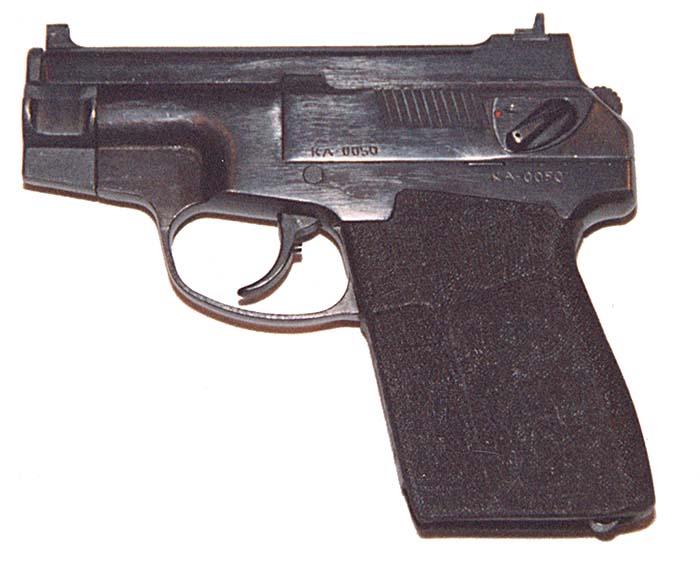
We were not afforded the opportunity to fire the SPP-1 underwater pistol or APS underwater rifle because to do so would have involved putting several dozen persons of varying firearms handling ability underwater with loaded weapons. Live firing was thus limited to two military divers who fired both weapons at underwater targets. Both weapons performed flawlessly. It would appear that both of these weapons merit a complete evaluation by police and military forces who have a requirement for such items, as they fulfill unique requirements.
The final item we were allowed to observe, but not test fire, was the NRS-2 Special Scout Knife,” which seems to be the answer to a question that nobody asked! The reason that none of the attendees was allowed to fire the NRS-2, was that the user must be very careful when firing it not to shoot off his fingertips! The NRS-2 fires one SP-4 silent cartridge, but the position that must be used to fire the knife is such that it cannot be accurate at anything other than pointblank range, and it takes so long to get the NRS-2 properly positioned in one’s hand to preclude losing one’s fingers that it would appear to be far better to simply carry a PSS silent pistol and use the sharp end of the knife if one were to encounter close-in threats. A close examination of the hands of the Marine firing the NRS-2 in the accompanying illustration will give the reader an idea of the contorted position that is necessary to fire this bizarre weapon. Space precludes loading and reloading procedures for the NRS-2, but suffice it to say that they are not conducive to rapid fire.
TsNIITochmash has developed a family of small arms which should be of great interest to military and police special operations users. With the exception of the bizarre NRS-2 “Special Scout Knife” and the excessively light trigger pull of the Gurza pistol, which could easily be corrected, all of the weapons are well-designed, robust and reliable. The weapons are unfortunately not currently available in the West, but it is possible that export may begin in 1998 with firearms and ammunition available to qualified military and police users.
| This article first appeared in Small Arms Review V1N7 (April 1998) |











